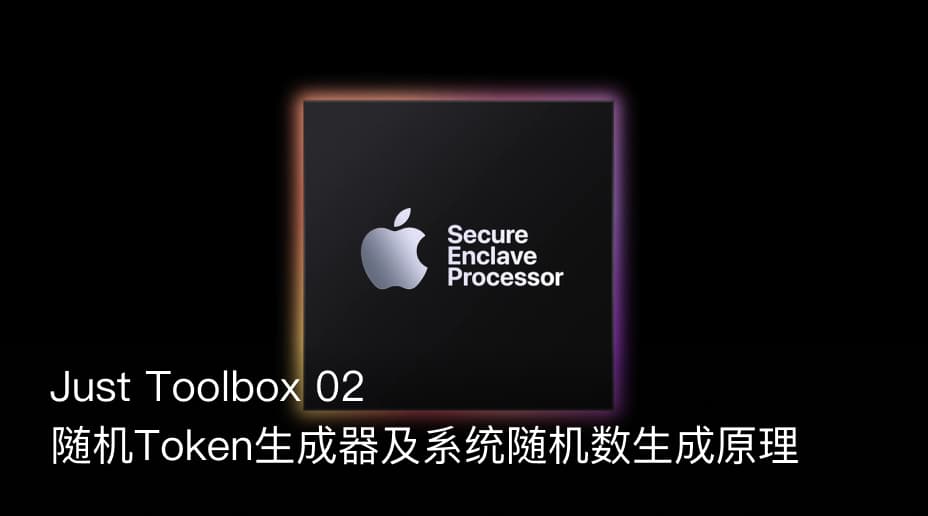
Just Toolbox 是基于SwiftUI开发的,运行在iPhone, iPad, watchOS, macOS和visionOS的免费的App。App涉及到的Tool实现我会在github和这里以文章的形式开源代码及讲述实现原理。如果大家对本系列感兴趣的话,欢迎在App Store下载 支持。
生成随机Token的实现很简单,把大写字符,小写字符,数字字符还有符号字符四种拼到一起,再随机一下单个字符即可,代码如下:
@State private var uppercaseEnabled = true
@State private var numbersEnabled = true
@State private var lowercaseEnabled = true
@State private var symbolsEnabled = false
@State private var length = 64
func createToken() -> String {
let uppercase = uppercaseEnabled ? "ABCDEFGHIJKLMOPQRSTUVWXYZ" : ""
let lowercase = lowercaseEnabled ? "abcdefghijklmopqrstuvwxyz" : ""
let numbers = numbersEnabled ? "0123456789" : ""
let symbols = symbolsEnabled ? ".,;:!?./-\"'#{([-|\\@)]=}*+" : ""
let originStr = (uppercase + lowercase + numbers + symbols)
let shuffledStr = String(repeating: originStr, count: length / originStr.count + 1).shuffled
let endIndex = shuffledStr.index(shuffledStr.startIndex, offsetBy: length)
return String(shuffledStr[..<endIndex])
}其中Collection的shuffled方法是这样的:
extension RangeReplaceableCollection {
var shuffled: Self {
var elements = self
return elements.shuffleInPlace()
}
@discardableResult
mutating func shuffleInPlace() -> Self {
indices.forEach {
let subSequence = self[$0...$0]
let index = indices.randomElement()!
replaceSubrange($0...$0, with: self[index...index])
replaceSubrange(index...index, with: subSequence)
}
return self
}
func choose(_ n: Int) -> SubSequence { return shuffled.prefix(n) }
}内部实现
那么Swift的randomElement()又是如何实现的呢?它的源码在: https://github.com/swiftlang/swift/blob/ac0f574fdb9d9bbaa6a60a4815c5e20c051604ac/stdlib/public/core/Collection.swift#L954
/// Returns a random element of the collection.
///
/// Call `randomElement()` to select a random element from an array or
/// another collection. This example picks a name at random from an array:
///
/// let names = ["Zoey", "Chloe", "Amani", "Amaia"]
/// let randomName = names.randomElement()!
/// // randomName == "Amani"
///
/// This method is equivalent to calling `randomElement(using:)`, passing in
/// the system's default random generator.
///
/// - Returns: A random element from the collection. If the collection is
/// empty, the method returns `nil`.
///
/// - Complexity: O(1) if the collection conforms to
/// `RandomAccessCollection`; otherwise, O(*n*), where *n* is the length
/// of the collection.
@inlinable
public func randomElement() -> Element? {
var g = SystemRandomNumberGenerator()
return randomElement(using: &g)
}这里面SystemRandomNumberGenerator()在不同平台有不同的实现,Swift标准库里只是链接了一个符号,官方文档说:
- Apple platforms use
arc4random_buf(3). - Linux platforms use
getrandom(2)when available; otherwise, they read from/dev/urandom. - Windows uses
BCryptGenRandom.
我们看看Apple platforms的实现arc4random_buf,它的实现是FreeBSD项目中Libc里,源码在这里:
void
arc4random_buf(void *_buf, size_t n)
{
u_char *buf = (u_char *)_buf;
int did_stir = 0;
THREAD_LOCK();
while (n--) {
if (arc4_check_stir())
{
did_stir = 1;
}
buf[n] = arc4_getbyte();
arc4_count--;
}
THREAD_UNLOCK();
if (did_stir)
{
/* stirring used up our data pool, we need to read in new data outside of the lock */
arc4_fetch();
rs_data_available = 1;
__sync_synchronize();
}
}这里面最重要的其实是这个函数arc4_fetch(),这个函数是系统用来取随机源的实现,它的代码如下:
static void
arc4_fetch(void)
{
int done, fd;
// 下面这个RANDOMDEV是
// #define RANDOMDEV "/dev/random"
fd = _open(RANDOMDEV, O_RDONLY, 0);
done = 0;
if (fd >= 0) {
if (_read(fd, &rdat, KEYSIZE) == KEYSIZE)
done = 1;
(void)_close(fd);
}
if (!done) {
(void)gettimeofday(&rdat.tv, NULL);
rdat.pid = getpid();
/* We'll just take whatever was on the stack too... */
}
}操作系统会从/dev/random这个设备获取熵源,这是典型的Unix-like OS的实现,另一个设备是/dev/urandom,在苹果的操作系统中,这两个的实现没有区别。
早期系统实现是从硬件收集各种熵源(entropy source),然后使用加密算法(比如ChaCha20)加密存储。苹果可能从2019年或更早就它们的算法切到Fortuna,使用的熵源包括(原文地址):
- Secure Enclave硬件给出的真随机数
- 启动阶段的CPU执行时间差(参考这篇文章介绍什么是CPU execution time jitter)
- 硬件中断信号(比如键盘鼠标事件之类的)
- 启动时保存起来的随机种子文件
- Intel的随机指令 — 比如
RDSEED和RDRAND(只有Intel-based Mac才能用)
看起来这里面最厉害的还是iPhone 5s时代推出的安全专属硬件Secure Enclave处理器。一般我们应用随机数结果的地方,像上面的Token就是用来做校验的。如果攻击者知道随机种子是什么,那么伪随机生成的结果就是固定的,他就可以推测随机结果,通过Token校验。苹果采用的硬件级真随机熵源就能很好应对这种攻击。
